A HOUSING CRISIS PROFILE IN LEADERSHIP

PLACES SUN
OCEANFRONT HOMES, AS TOLD BY HOMEBUILDER MARK BATSON AND OTHERS WITH EYES ON THE COAST in the MARKET STREET MAKEOVER











A HOUSING CRISIS PROFILE IN LEADERSHIP

OCEANFRONT HOMES, AS TOLD BY HOMEBUILDER MARK BATSON AND OTHERS WITH EYES ON THE COAST in the MARKET STREET MAKEOVER










CAROLINA, Grandma would tell my sister and me stories each night to make us quiet and go to sleep. They were the classic fairy tales, of course, with the sort of traumatizing but also improbable swallowing of Little Red Riding Hood’s grandma by the big bad wolf, but also songs and silly stuff like copious renditions of Peter Piper Picked a Peck of Pickled Peppers.
Maybe that’s why I like stories so much.
We spent a lot of time with Grandma and Grandpa – my maternal grandparents – because my parents drove us frequently on weekends from our home in Spartanburg to their house in Hendersonville, another North Carolina town popular among retirees. My grandparents bought the house about 50 years ago, and it was the scene of multiple massive breakfasts made by Grandma, Easter egg hunts and games of hide-and-seek.
When I was 6 years old and hiding from my sister under some clothes in my grandmother’s walk-in closet, I didn’t think about the importance of having a place to call home. Through covering real estate for nearly 10 years for the Greater Wilmington Business Journal, I’ve learned a lot about the housing market, but there’s still so much more to know. One thing I have discovered through owning my own house and now pondering the fate of the house my grandparents bought before I was born is that every home has a story. And every housing market has its own stories, something we’ve tried to capture for the Wilmington area in the following pages.
In this year’s residential real estate issue of WilmingtonBiz Magazine, you’ll find opinions about the struggle to build affordable housing in Wilmington (page 30) and a story about oceanfront homes worth millions (page 18).
Staff writer Emma Dill shines a spotlight on
Market Street (page 24), the busy Wilmington thoroughfare known more for motels and car lots than housing. Dill explains how developers have been turning some of those motels into market-rate housing in a city where the demand continues to rise, but the availability of affordable housing continues to shrink.
Each year, the magazine also provides a snapshot of the area’s residential market (pages 4346), including the top-selling residential real estate firms and agents and the highest-priced residential transactions of the previous year.
Freelancer Beth Klahre delves into the background and insights of Amanda Parmer (page 34), president of BlueCoast Realty and 2024 president of Cape Fear Realtors.
Hopefully, the stories between these pages will give readers information they want and need about the region’s residential real estate market.

2024 REAL ESTATE ISSUE – $4.95
P ublisher
Rob Kaiser rkaiser@wilmingtonbiz.com
P resident
Robert Preville rpreville@wilmingtonbiz.com
e ditor
Vicky Janowski vjanowski@wilmingtonbiz.com
M anaging e ditor
Cece Nunn cnunn@wilmingtonbiz.com
r e P orters
Emma Dill edill@wilmingtonbiz.com
Audrey Elsberry aelsberry@wilmingtonbiz.com
V ice P resident of s ales & M arketing
Angela Conicelli aconicelli@wilmingtonbiz.com
s enior M arketing c onsultants
Maggi Apel
Craig Snow
Kimberly Stamper
Stacey Stewart
M arketing c onsultants
Alexis Alphin
Jillian Hon
d igital c lient success c oordinator
Jessie Vincoli jessie@wb360marketing.com
e V ents d irector
Jamie Merrill jmerrill@wilmingtonbiz.com
e V ents & M arketing c oordinator
Alecia Hall ahall@wilmingtonbiz.com
a rt d irector - e ditorial
Suzi Drake art@wilmingtonbiz.com
a rt d irector - M arketing
Tara Weymouth tweymouth@wilmingtonbiz.com
M edia c oordinator
Julia Jones jjones@wilmingtonbiz.com
d irector of f east W il M ington
Jessica Maurer jmaurer@wilmingtonbiz.com
c ontributing P hotogra P hers Logan Burke, Madeline Gray, Malcolm Little
s ubscribe
To subscribe to WilmingtonBiz Magazine,visit wilmingtonbiz.com/subscribe or call 343-8600 x201.
© 2024 SAJ Media LLC

LOGAN BURKE is from St. Louis but moved to Wilmington to get away from the busier paces of life. With a background in business, photography wasn’t always in Burke’s background. It wasn’t until his father left him with some camera equipment and curiosity to understand it all. After a few times behind the camera, he developed a motivated interest to learn what made the picture. Burke photographed housing units along Market Street on PAGE 24 loganburkephoto.com

MADELINE GRAY is a freelance documentary photographer based in Wilmington. She has a master’s degree in photojournalism, and her work is featured in local and national publications. She enjoys spending time off the beaten track and collaborating to share diverse stories. Gray photographed homebuilder Mark Batson for the cover of the Residential Real Estate Issue and the story about beach home trends (PAGE 18) as well as construction on Oleander for the Takeaway pic (PAGE 47). madelinegrayphoto.com and @madelinepgray on Instagram

VICKY JANOWSKI is editor of the Greater Wilmington Business Journal and its sister publication WILMA magazine. She has reported and edited on topics ranging from business to politics to health care. Janowski interviews Ernie Bovio, president of Novant Health NHRMC and Novant’s coastal market, for the issue’s C-Suite Convo feature on PAGE 16 .

CECE NUNN has been writing and editing for more than 20 years, currently working as managing editor and residential real estate reporter for the Greater Wilmington Business Journal. She lives in Wilmington with her husband and two daughters. Nunn edited this year’s Real Estate Issue and wrote about the beach housing market ( PAGE 18 ) and Q&A with affordable housing developers ( PAGE 30 ).



The N.C. DOT in January began a major repair project on the Cape Fear Memorial Bridge, which connects Wilmington to Brunswick County and beyond.
“While the bridge is safe, it is reaching the end of its lifecycle and must be monitored, inspected and maintained on a more frequent basis,” according to DOT officials. “Daily inspections of the steel vertical-lift bridge built in 1969 have shown the need to conduct longer-lasting improvements.”
The repairs required the closure of the bridge’s eastbound lanes, wreaking havoc on traffic patterns.
As of press time, the crews were repairing the bridge’s moveable grid deck and beams, known as stringers, that support the grid deck.
As of March 19, DOT officials planned for the repair work to be complete by May. Local and state leaders have been working on a way to fund the bridge’s replacement, which is expected to cost at least $437 million.
Our dedication to education is unwavering, reflective of our deep understanding of its fundamental role in the community’s prosperity and well-being, and our longstanding commitment to provide the resources that keep our teachers among the highest paid in North Carolina.
North Carolina general statutes and the state’s constitution dictate that it is the state’s responsibility to fund instructional and operational expenses, while county governments are responsible for the cost of capital expenditures like construction and maintenance of school facilities and athletic facilities.
To that end, since 2006, New Hanover County has committed over $273 million toward capital costs for the public schools and has allocated another $40+ million in total annual appropriations to the schools for capital purposes.
Porters Neck Elementary, Castle Hayne Elementary and Holly Shelter Middle are just a few examples of schools built with funds raised by the county.
Additionally, the Board of County Commissioners, by choice and not by legislative directive, annually appropriates a significant amount of local revenues to provide funding to supplement the state’s operating funding allocation.
In fiscal year 2024, New Hanover County appropriated $94 million in operational support for the county schools. This amounted to approximately $3,434 per student and ranked the county seventh out of all 100 counties in North Carolina in operational support according to the most recent data.
This is greater than the amounts appropriated
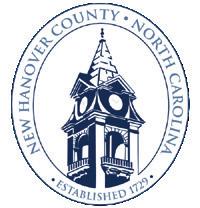
Joint op-ed by
for students in Brunswick, Pender and Wake.
Furthermore, the county’s contributions extend beyond basic operational and capital funding.
In fiscal year 2024, the county is investing in several vital programs including $1.9 million for pre-K classes; $2.1 million for school nurses, ensuring nursing coverage at all schools; $3.5 million for mental health therapists in elementary and middle schools; and $4.1 million for school resource officers at all public schools.
An additional $1.3 million is allocated for community resource coordinators and almost $1.9 million for violence reduction programs.
In total, we are allocating approximately $140 million of local, county revenues to our public schools this year, which equates to $5,229 per student based on current enrollment numbers.
As a matter of context, we achieve this significant funding with a tax rate that is affordable to all taxpayers – 45 cents per $100 of value, which is the 16th-lowest in the state and is, in fact, the lowest of any of the most populated counties in the state.
For comparison, the average property tax rate in the 100 counties in North Carolina is $0.64 per $100 of valuation.
As stewards of taxpayer funds, we are tasked with the careful balancing of ambitious educational support, prudent fiscal management, and setting revenue rates that ensure all earners can afford to live in New Hanover County.
We recognize that our decisions directly impact
not only the current generation of students but also the long-term viability of our educational system. We are proud of the commitment we make.
While resolute in our efforts, we must also acknowledge the limitations in the scope and extent of our board’s capabilities and responsibilities. The constitution of this great state charges the state to fund a high-quality public education. We enhanced that with $140 million of local taxes this past year.
We understand the gravity of the Board of Education’s budgetary constraints brought about largely by expiring federal grants and financial decisions made by the NHC Board of Education, but our goal remains to secure the best possible educational outcomes within our means, ensuring that our decisions are both fiscally responsible and educationally sound.
This delicate balance is crucial for the sustained success and advancement of our educational system in New Hanover County.
The New Hanover County Board of Commissioners is made up of five elected commissioners: chair Bill Rivenbark, vice chair LeAnn Pierce, Jonathan Barfield Jr., Dane Scalise and Rob Zapple.
EDITOR'S NOTE: The Greater Wilmington Business Journal and WilmingtonBiz Magazine publishes op-eds about ideas for sparking economic growth in the region. If you have a column topic to be considered, email editor@ wilmingtonbiz.com.
WHAT WOULD YOU LIKE TO SEE – OR NOT SEE – ON THE WEST BANK OF THE CAPE FEAR RIVER ACROSS FROM DOWNTOWN WILMINGTON?
“A PARK WITH ELEVATED walks and bird viewing areas. Picnic tables. Like Huntington State Park south of Myrtle Beach.” –LYNN CANNON LEAKE
“A PARK WITH A WEST bank river walk that mirrors the other side of the river the first 50 feet from the water, and then a minor league baseball stadium complex behind that.” –TERRY TRIPLETT
“I THINK A THEME PARK/WATER park would be a great idea or a nature center like the Greensboro Science Center. It would be less impact on the environment. It would add to the economy and local attractions as well.” –RYAN WETZEL
“PARKS AND PROMENADES , running and bicycling paths, kayaking trails, and limited development in anticipation of som e sea level rise. Leave wetlands as wetlands.” –JESS WEISS
X (FORMERLY KNOWN AS TWITTER) POLL: @WILMINGTONBIZ
ARE YOU INTERESTED IN BUYING AN EV (ELECTRIC VEHICLE)?
NO
YES
WILMINGTONBIZ.COM
“WHAT I SEE IS THAT THE LISTINGS IN TOPSAIL BEACH and Surf City are virtually nothing, and without those listings, you’re never gonna get your volume up in sales.” -JIM CORNELISON, OF CAROLINA REAL ESTATE IN SURF CITY, ON THE LACK OF HOMES CURRENTLY FOR SALE DURING A PANEL TALK ABOUT REAL ESTATE TRENDS IN PENDER COUNTY


has had a volatile few years, industry officials said recently.
It felt the effects of the COVID-19 pandemic starting in 2020, then bounced back with a record year in 2021 with more than $300 million in direct local spending, said Johnny Griffin, director of the Wilmington Regional Film Commission.
After last year’s strikes by the Writers Guild of America (WGA) and Screen Actors Guild-American Federation of Television and Radio Artists (SAG-AFTRA), local spending dropped to around $43 million in 2023.
Then in September, Cinespace Studios, one of the world’s largest stage and production services providers, acquired the EUE/Screen Gems Studios complex in Wilmington – a historic change for the region’s film industry.
The changes and upcoming film industry topics, ranging from economic incentives and crew diversity to the need for ongoing workforce development, were the focus of a panel talk last month.
Panelists at the Greater Wilmington Business Journal’s Power Breakfast were Griffin; Dan Brawley, chief instigating officer of Cucalorus Film Festival; Susi Hamilton, president of the Film Partnership of North Carolina; Kristi Ray, creative producer and co-founder of Honey Head Films; and Ashley Rice, president of Cinespace Studios.
Rice said Cinespace chose to buy the Wilmington studio to diversify its offerings. The company also purchased Screen Gems’ studios in Atlanta in the same deal, adding the two Southern cities to its other studios in Chicago, Toronto and Germany.
“We wanted a really diverse portfolio under one global roof that we could serve as a lot of different creative needs for filmmakers,” Rice said. “We feel that Wilmington fits in really, really well to that. Naturally, a coastal city, it has a different look and feel to our other cities.”
Even with the recent shifts, Wilmington maintains a reputation for industry experience, according to Brawley.
“Wilmington is in a really special position as being a town that has a legacy in the film industry,” he said. “People know that when they come to Wilmington there’s a depth of experience and that’s not necessarily the case everywhere you go.”









Construction is underway on the Salvation Army’s long-awaited Center of Hope.
Major Ken Morris announced the milestone on March 14 during an event at downtown Wilmington’s The Harrelson Center. According to Salvation Army leaders, the Center of Hope will serve as a homeless shelter and a central hub for the Salvation Army’s programs.
The new 20,500-square-foot facility will be on 22 acres at 1220 N. 30th St., bordered by the Creekwood neighborhood and Martin Luther King Jr. Parkway.
As of mid-March, crews were clearing the land. The next order of business was to create another access point to the property. The only road currently providing access to the site is far from where the center is set to be constructed, Morris said on March 14.
Then, crews will start laying the foundation for the center and
working on the first of the project’s two phases. The Salvation Army is working on the project with McKinley Building Corp. and architecture firm LS3P.
The proposed shelter will have 75 beds, including seven suites specifically designed for families. Morris said the suites will help the group better serve the area.
“This will actually help us even better help the homeless in our community,” he said. “The previous shelter only had a men’s side and women’s side; this will have the suites for the families as well, which is desperately needed in this community.”
The Salvation Army previously operated a facility on Second Street in downtown Wilmington. It closed last May after the city of Wilmington purchased the property for $4.8 million.
Morris said the group aims to have the Center of Hope up and running by next spring.

Janet Kane was named CEO of Wilmington-based Cape Fear Realtors this year.
Kane served as interim CEO of CFR in January after the departure of previous CEO Anne Gardner, who served in the role since 2019.
“Her wealth of knowledge and extensive background in association management made her an ideal fit to guide the local association of Realtors through a transitional period,” a news release stated.
Amanda Parmer, 2024 president of CFR and president of BlueCoast Realty Corp., stated in the release that Kane’s “exceptional skills and visionary leadership are poised to elevate our team to new heights.”
Kane’s most recent role before coming to CFR was as CEO of MetroTex Association of Realtors, a 26,000-member organization in Dallas.
She said of CFR, “I look forward to working side by side with our volunteers and staff team as we find new and innovative ways to ensure Cape Fear Realtors continues its history of providing excellent service and value to our members and the community.”
$650K
ERNIE BOVIO STARTED IN JANUARY AS PRESIDENT OF NOVANT HEALTH NEW HANOVER REGIONAL MEDICAL CENTER AND NOVANT’S COASTAL REGION, WHICH INCLUDES HOSPITALS AND PHYSICIAN OFFICES IN NEW HANOVER, BRUNSWICK AND PENDER COUNTIES.
Bovio has worked for decades as a health care executive, including most recently as head of UNC Health’s Triangle East Region covering UNC Health Rex in Raleigh and three other hospitals.
Below is a recent Q&A with Bovio from the Business Journal’s WilmingtonBiz Talk. To watch the full interview, go to WilmingtonBiz. com.
WHAT ARE YOUR GOALS COMING INTO (NOVANT’S) COASTAL MARKET HERE AROUND WILMINGTON?
“Continue some of the great work that’s being done now to … build more capacity because the way that this community is growing, we certainly need it. A lot of effort towards adding hospital beds, operating rooms, medical office space, recruiting more physicians. We’re probably going to be bringing in 25 to 30 new physicians every year for the
 ERNIE BOVIO PRESIDENT, NOVANT HEALTH NEW HANOVER REGIONAL MEDICAL CENTER
ERNIE BOVIO PRESIDENT, NOVANT HEALTH NEW HANOVER REGIONAL MEDICAL CENTER
foreseeable future, both primary care and specialty care to keep up with the growth.”
SPEAKING OF PHYSICIANS AND WORKFORCE ISSUES … WHAT’S YOUR TAKE ON AVAILABILITY, PARTICULARLY WITHIN NURSING?
“The nursing shortage has affected health care systems all over the place; Wilmington’s not immune to that. What we’re working on now is both recruitment efforts and retaining the existing staff that we have. You may have seen recently the $10 million commitment that Novant Health has made to partner with UNCW and Cape Fear Community College to provide scholarships for those going into nursing and health care. … We’ve also developed a nurse residency program that’s been very successful. So, graduate nurses coming into New Hanover Regional can rotate through a residency program to find the perfect fit for them and get them into the specialty
that they’re interested in, where they can excel and grow their career. And then on the retention side, I think we’ve done a really good job of limiting the reliance on contract labor nurses. We’ve seen a steady decline from a peak a couple of years ago to where we are today, and that trajectory, that trend continues to go down. We’ve had many contract labor nurses that have converted to full-time employees with New Hanover Regional.”
ARE THERE ANY OTHER ISSUES OR THINGS THAT YOU SEE MOST PRESSING AS YOU’RE COMING INTO THIS ROLE?
“Access is really important. We’re excited about the opening up of the first Novant Health Michael Jordan Family Medical Clinic in Wilmington. There’s two in Charlotte; this will be the first in Wilmington. It’s been designed with the purpose of serving traditionally underserved communities. We’ll break ground on the second Michael Jordan clinic shortly after this one opens. … It will serve a need that’s currently unmet right now. In addition to that, we launched the community cruiser a couple of months ago for the same purpose, really trying to get out to some areas that don’t have access.”
WITH YOUR BACKGROUND, YOU’VE HAD INSTANCES WHERE YOU’VE BEEN A PART OF HOSPITALS THAT HAVE CHANGED OWNERSHIP … WHAT HAS BEEN YOUR IMPRESSION COMING INTO WILMINGTON (WHERE NHRMC CHANGED FROM A COUNTY-
OWNED HOSPITAL TO BEING BOUGHT BY NOVANT HEALTH IN 2021)?
“I have been a part of organizations that have either been acquired or have acquired others and have been through situations where integration with a different organization takes place, and that’s always challenging. There are cultural changes and disruptions that occur, whether it’s information systems, transformations, transitions or just policy changes. Organizations work differently. And if you think back over the past three to four years (for NHRMC): acquisition pandemic staffing challenges, integration with the new organization, new president, there’s been some disruption, some uncertainty – a lot of change that our medical staff and our team members have gone through, and they’ve done a pretty incredible job. … I think they weathered a lot of that disruption very, very well.”
IT SEEMS LIKE NOVANT’S BEEN MOVING MORE INTO SOUTH CAROLINA. … DOES THAT FALL UNDER THE COASTAL MARKET AS WELL?
“That’s still to be determined. We have a partnership with Conway Medical Center, and we have a joint venture with them. The proximity of Conway Medical Center (in Horry County near Myrtle Beach) to us is such that we will be able to work together to help them build more advanced services and programs and also serve as a regional referral center for them as well. Currently, they’re sending some of their more subspecialty, high-end tertiary quaternary care to MUSC (Medical University of South Carolina) in Charleston, and we’re a little bit closer and offer many of the same services. So that’s an opportunity for us as well.”



“The idea behind building a beach house was to not invest heavily in its construction, understanding that storms could easily destroy it. The intention was not to create the best-built structures since you didn’t want to have a significant amount of money tied up in something that might be taken down by a storm,” said Mark Batson, a Wilmington custom homebuilder specializing in luxury houses, including oceanfront properties. “Consequently, many of the homes we’re demolishing today, some of which are barely 30 years old, were never meant to endure. They’re simply falling apart.”
Batson, who owns Wilmingtonbased Tongue & Groove Design + Build, said he approaches building oceanfront homes as structures that will still exist in 100 to 200 years.
“These will last as long as they’re maintained. Our goal is to build houses that are worthy of preservation,” he said. “For the next generations that come along, I don’t want them walking into a Tongue & Groove house and wanting to tear it
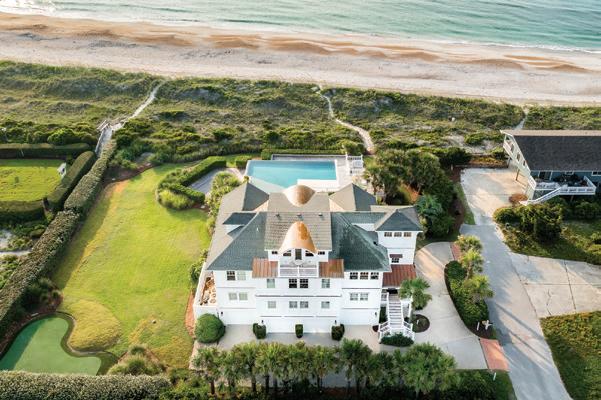
down. Instead, I want them to walk in and say, ‘OK, this is a good house. This is worthy of preservation.’”
While many oceanfront homeowners have the means to weather figurative and literal storms, facets of that ownership include rising prices, upkeep, storm threats, sea-level rise, insurance costs and the possibility that they might not be allowed to rebuild a destroyed house because of setback requirements.
The prices of oceanfront homes, particularly unique, contemporary properties, have increased in recent years. The buyers of the house at 10 Inlet Hook on Figure Eight Island set a record in 2023 when they paid $13 million for the property. The home
ABOVE: 7 Cowrie Lane
OPPOSITE PAGE: Mark Batson at 901 Fort Fisher Blvd.

“ “
These will last as long as they’re maintained. Our goal is to build houses that are worthy of preservation. For the next generations that come along, I don’t want them walking into a Tongue & Groove house and wanting to tear it down. Instead, I want them to walk in and say, ‘OK, this is a good house. This is worth saving.
MARK BATSON custom homebuilder and owner of Tongue & Groove Design + Buildwas designed by architect David Lisle and built in 2022 by Whit Honeycutt, of North State Custom Builders.
Ransom and Courtney Langford, of Connecticut, purchased the nearly 5,000-square-foot home on the private New Hanover County island from John and Rebekah McConnell, of Raleigh.
According to real estate agents, that’s the highest sum paid for a house in recorded history in New Hanover County.
John McConnell, of McConnell Golf, purchased the lot for the custom home for $1.5 million in 2020.
Buzzy Northen, of Wilmingtonbased Intracoastal Realty Corp., represented the buyers in the transaction, while Jo El Skipper, of Figure Eight Realty, represented the sellers.
Real estate agents say it’s important to put recent eight-figure oceanfront sales in perspective.
On Figure Eight Island and in Wrightsville Beach, homes selling for over $10 million “are all homes built in the last six years or homes with extremely rare features such as oversized lots,” said Trey Wallace, president of Intracoastal Realty, when the news broke about the $13 million deal. “While we have certainly seen a run-up in prices over the past three years, these new price thresholds are being met in combination with some of the first newly built ultra-luxury
homes turning for the first time.”
Wallace pointed out that the home at 407 Bradley Creek Point, which sold for $5 million in November 2018, set a record.
“Only five years later, we are approaching new sales records of $13 million,” he said. “It is certainly an incredible new price scale for our region. There will be more sales like this, to be sure, but only the most ultra-luxurious and modern builds will be able to command these prices, in my opinion.”
Modern properties continue to reach new price heights. In Kure Beach, buyers this March paid $9.2 million for 901 Fort Fisher Blvd. –a record price for a home sale on Pleasure Island, which includes Kure and Carolina beaches.
The sale was for a double lot on the oceanfront holding a main house and guest house designed and built by Tongue & Groove.
Batson said both structures, built in 2021, have the same material palette, including cedar shingles and copper roofs, but they’re a little different architecturally.
Batson can understand the appeal of Pleasure Island, where he grew up working on his father’s fishing boat.
In a LinkedIn post accompanying Batson’s announcement about the 901 Fort Fisher Blvd. sale, Batson

wrote, “Witnessing the evolution of our island communities over the decades has been a journey laden with nostalgia, pride and a sense of accomplishment. The metamorphosis from simple seasonal retreats to vibrant, year-round communities is a testament to the resilience, innovation, and spirit of those who, like my family, have called these beaches home.”
Peter Sweyer, a Realtor with Berkshire Hathaway HomeServices Carolina Premier Properties, doesn’t live on the oceanfront but does live in Wrightsville Beach.
“There is something magical about hearing those waves at night or when it’s dark and having that kind of force of the ocean near you is very soothing and calming for some people,” he said.
Sweyer helped the previous owners sell the oceanfront home at 7 Cowrie Lane in Wrightsville Beach in December. He said the property was on the market for 100 days but attracted interest from seven qualified buyers. The first folks who looked at it ended up buying the home.
According to Sweyer, the 5,700-square-foot home sits on nearly an acre, one of the largest oceanfront lots in Wrightsville Beach. The home has five bedrooms, six-and-a-half bathrooms, an oceanfront pool and a four-car garage. The transaction marked the first time the home had been sold; the seller purchased it while it was under construction and used it as a second home for 19 years.
“The thing that made this property so unique was that it was on a large lot,” Sweyer said, adding that the initial buyers combined two lots, knocking down the house on the front lot and using that area for their pool.
Sweyer gives credit to the original owners for the home’s good condition.
“It’s a war of attrition to maintain an oceanfront house, so you certainly
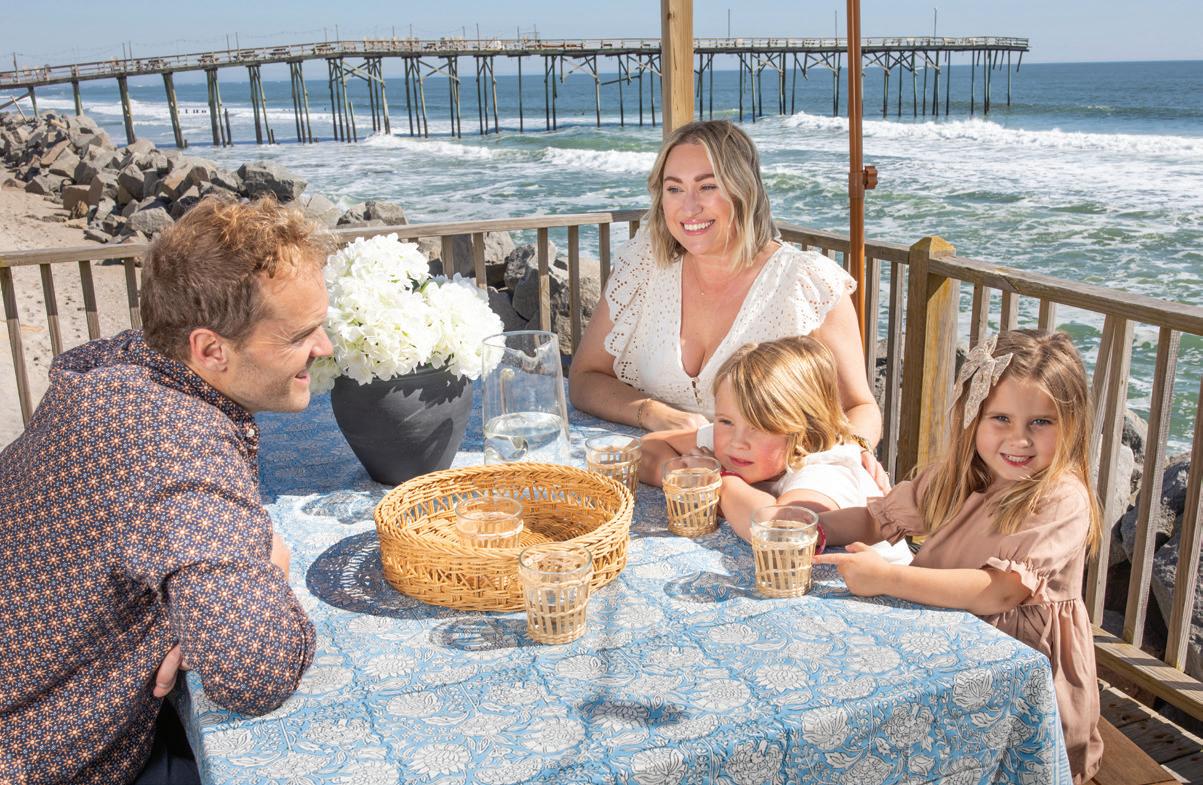
have to have the financial horsepower going into it,” he said, “not only to afford the purchase price but to be able to maintain it at a level that you would want to maintain it.”
Entrepreneurs Travis and Heather Sherry, who previously kept a home base in Pennsylvania, knew the risks and costs when they bought an oceanfront home in Carolina Beach during the pandemic.
They decided they could handle any issues that might come up.
“It feels like our own paradise here,” Travis Sherry said.
The couple bought the house at 1708 Carolina Beach Ave. N., within walking distance of Freeman Park, for $639,000 in August 2020. The 2,500-square-foot home feels like a beach bungalow.
“We’ve always really loved being near the water and going to the ocean,”
Heather Sherry said. “And so, when we talked at length for years about our ideal place to live, it was always the beach.”
They wanted a house priced under $1 million and could be flexible with a location because they worked remotely before the pandemic began in March 2020.
“We had never actually been here or even heard of Carolina Beach or knew anyone here,” Travis Sherry said. “I was looking at real estate, and Carolina Beach was one of the more affordable places up and down the coast.”
The day they closed on the house in 2020, Hurricane Isaias was bearing down on the East Coast.
“We’re signing the papers at the lawyer’s office, and they’re like, ‘You’ve got to run over to town hall immediately because they’re closing at noon … and you need to get a re-entry decal because a hurricane is coming,’” Travis Sherry recalled.

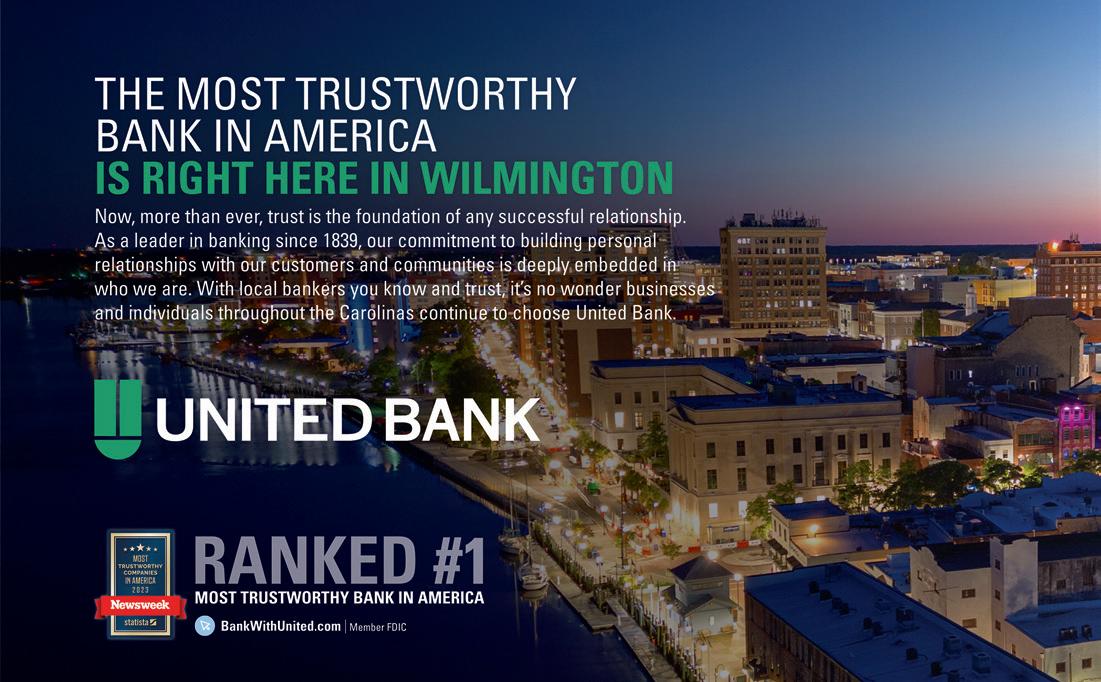
Without the decal, it would be difficult to return to Pleasure Island after the storm if officials issued a mandatory evacuation order.
They lost power in the middle of the night, but crews restored it by 10 a.m.
“We had a few shingles missing from the roof, and that was it,” Travis Sherry said.
The couple is still able to get homeowners insurance on the property. For Carolina Beach, the N.C. Rate Bureau has requested a 99.4% increase in insurance rates for the beach areas of New Hanover – which includes Carolina, Kure and Wrightsville beaches – Brunswick, Pender, Onslow and Carteret counties. The state’s insurance commissioner has rejected the rate hike, and as of press time, a hearing on the request was scheduled for October.
Travis Sherry said no homeowner wants an increase, although the couple feels they can cover one.
“But at the same time, I also feel fortunate that what’s happening in California and specifically Florida isn’t happening here where insurance companies are just pulling out completely, and you can’t get insurance,” he said.
Familiar investment principles apply to oceanfront homes, said Jim Cornelison, an agent with Carolina Real Estate of Topsail.
Despite the threat of storms, reports of sea-level rise and costs, people continue to buy oceanfront homes “because they’re a good investment when things are good. It’s like why you buy stock. Not all stocks are good; not all of them go up, and not all of them go up fast, but some do,” Cornelison said.
The Topsail Island towns of Surf City (No. 5) and North Topsail Beach (No. 8) are among the top 10 markets in the U.S. targeted by investors for beach homes, according to a National Association of Realtors article citing a study by vacation rental home company Vacasa.
Cornelison said while the island does have buyers who are strictly speculators, “the average person coming down here is buying a beach house because they want one for their family to enjoy.”
Prices have been rising for homes along Topsail Island’s oceanfront, and even if a house was built in the 1960s and ’70s, “it’s still going to be probably $1 million,” he said.
A good, buildable lot by itself on the island is going to be worth about $1 million, Cornelison said. In the 1960s, people could buy an oceanfront lot in the Cape Fear region in some cases for about $500 to $800, he said.
These days, many of Batson’s oceanfront clients have a simple wish.
“It’s really just about these families wanting to spend time with each other,” Batson said, “and that’s what they’re buying – time with their family in a beautiful place.”

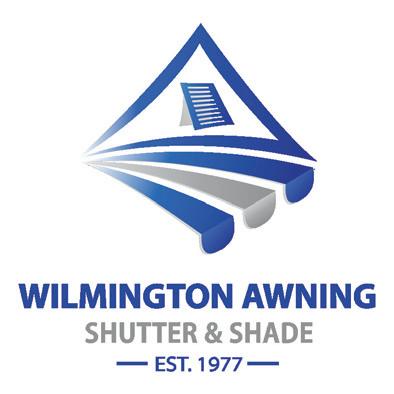
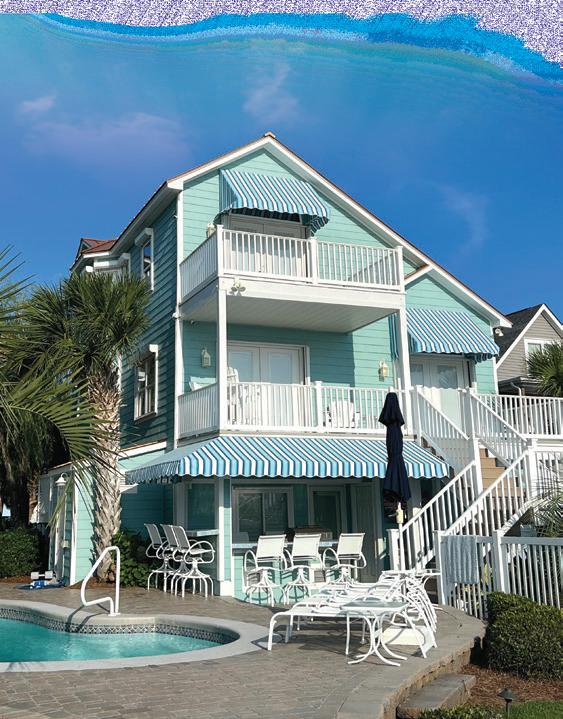

Along Wilmington’s bustling Market Street corridor, two commercial real estate brokers are eyeing change.
John Hinnant, vice president of Eastern Carolinas Commercial Real Estate, and Nick Silivanch, a partner with the firm, helped broker a deal to upfit Market Street’s former Budgetel Inn and Motel 6 into 230 apartments. The complex opened to renters last year.
Then, less than a half mile to the east, Hinnant and Silivanch helped broker another hotel-to-

apartment conversion. This time, developers converted the former Days Inn into 120 apartments.
The adaptive reuse of both hotel properties illustrates what Hinnant and Silivanch see as a broader trend along stretches of Market Street: a shift away from a retail-heavy corridor to one with a climbing number of apartments and residents.
Their work marketing to developers with an eye toward adaptive reuse dates back to 2021 when the two helped broker the sale of the former
According to property records, Suites on Market LLC purchased the 113-room motel, which sustained substantial damage from Hurricane Florence, in January 2021 for $2 million. The motel’s rooms have since been refurbished and converted into longterm rentals.
After that, the brokers started marketing hotel properties along the corridor to developers specializing in adaptive reuse.
“It’s wildly popular in other parts of the country,” Hinnant said about the hotel-to-apartment conversion trend, “and we’re starting to see the move come East.”
Some hotels along Market Street have a seedy history.
In 2016, the city of Wilmington took legal action against six hotel properties in the corridor, labeling them nuisances following repeated incidents of controlled substance use along with loitering and prostitution.
Wilmington filed a lawsuit in July

2016 against the owners of the targeted hotels, asking for a restraining order that would prevent the hotels from operating.
The hotel owners ultimately agreed with city leaders to halt the restraining order. In exchange, they said they would require all guests to present a photo ID and a credit card when checking in, keep a hotel registry, issue parking permits to guests, employ an overnight security guard and install more security cameras, among other measures.
Hearing about the legal issues was, in part, what initially piqued Silivanch’s interest in trying to draw redevelopment to pockets of the corridor, he said.
Hinnant and Silivanch started by contacting owners of Market Street hotels to see whether they were interested in selling their properties. He hoped they could “cookie cutter” the type of conversion that took place at the former AmeriVu Inn, Silivanch said.
They found success with two adjacent hotels – a former Budgetel Inn and Motel 6.
Located at 4903 Market St., the two operated out of a shared lobby and had an on-site restaurant. The buildings were built in 1965, according to New Hanover County property records, and housed several hotel chains over the years.
California-based Vivo Investment Group purchased the properties for $11 million in late 2021. The company specializes in “purchasing older, underutilized hotels and converting them into affordably priced apartments with hotel-type amenities,” according to Leslie Moody, of Vivo Living.
When identifying prospective properties, the company looks for 120 to 600 units in areas that are walkable or near transit corridors. It also looks for sites that are already zoned for residential units.
When Vivo officials started looking at the site, that zoning wasn’t in place for the Wilmington property. In the fall of 2021, Vivo secured a rezoning from Wilmington leaders with the condition
that at least 10% of the new apartments be reserved for affordable housing.
“All we did was take it through a zoning process. Yesterday, it was a hotel, we turned the lights off,” Silivanch said. “This morning, after the council meeting, we turned the lights on – it’s an apartment complex for zoning (purposes).”
The following year, Vivo started renovating the property. They added kitchens to each unit, changed the former restaurant into a game room and completed deferred maintenance on the property.
The complex began leasing to tenants in early 2023. The floorplans of Vivo’s studio units are small, with floorplans ranging from 223 to 311 square feet, according to online listings. Monthly rental rates range from around $800 to just over $1,000.
Around the time Vivo was upfitting its property, Hinnant and Silivanch set their sights on brokering another adaptive reuse at a property just down the road.
According to Hinnant, the former Days Inn at 5040 Market St. suffered significant damage during Hurricane Florence, which caused mold to spread throughout the 120-room hotel.
Preston Dellinger, the firm’s chief operating officer and managing principal, said in February that the brokers approached Servio Capital Investments Inc., a Louisiana-based real estate investment firm, about 18
WE’VE GOT VERY LITTLE LAND LEFT IN NEW HANOVER COUNTY, SO WE’VE GOT TO LOOK AT THESE OLDER CORRIDORS. … THESE OLDER CORRIDORS WITH ONE- AND TWOSTORY BUILDINGS ARE GOING TO BE EVENTUALLY REDEVELOPED INTO MORE OF AN URBAN CONTEXT SO THAT WE CAN GET MORE DENSITY.JOHN HINNANT vice president, Eastern Carolinas Commercial Real Estate
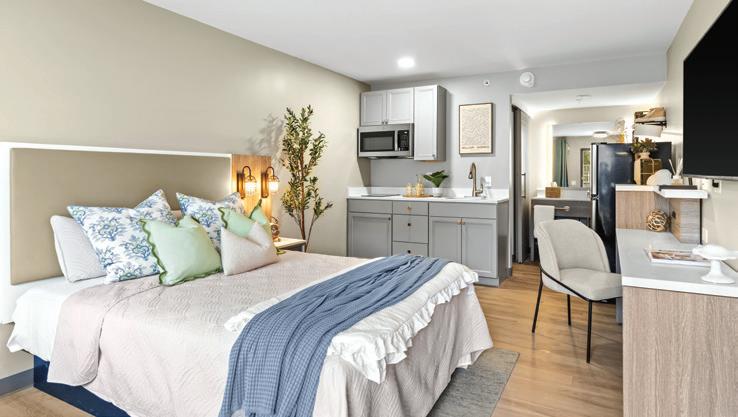



months ago with the Days Inn property.
The company has some history with adaptive reuse, having converted a 275-key hotel in Lafayette, Louisiana, into 217 apartments, Dellinger said.
The company acquired the Market Street property last April and has since worked to renovate the complex, taking the building down to the studs; installing new drywall, cabinetry and fixtures; and painting the walls.
“Everything is brand new inside,” Dellinger said.
Construction is ongoing at the former hotel’s two main buildings. Dellinger said in February his firm
hoped to wrap up work on both buildings by the end of March. The firm is also securing a user for a former restaurant building along Market Street. They hope to bring in another restaurant, he said. According to Dellinger, Servio Capital evaluates properties for potential adaptive reuse based on three factors: whether it’s in a market with a growing population, the location of the property within that market and whether the project makes financial sense.
“You mix those three together, and that’s what drives your decision,” he said.
Hotels are ideal for adaptive reuse because they have an existing footprint with infrastructure like plumbing and electrical wiring. That helps make the cost of adaptive reuse substantially lower than building from the ground up, Dellinger said.
As an asset class, the hotel market remains strong, which Dellinger said has made it more expensive to acquire hotel properties for a conversion to apartments. Instead, some firms that want to convert existing commercial space into residential units are turning to offices – a sector that’s been “taking a beating” since the COVID-19 pandemic, Dellinger said.
“That’s being looked at pretty hard by development companies like ours to take office and turn those into apartments, but they’re a lot harder to do than hotels,” he said. “Hotels are already sectioned off, and if you want to create combined units, it’s much easier to do so. A lot of them have already connecting doors.”
Hinnant and Silivanch envision bringing the adaptive reuse model to other motels in the Market Street corridor. They’re in talks with the owners of some other hotels and see a handful of other parcels on Market Street as prime spots for redevelopment.
Hinnant points to the building that housed Wilmington’s AMC movie theater for years near the intersection of Market Street and Kerr Avenue until its doors closed last fall. He also sees potential in vacant space in several Market Street strip malls and some undeveloped land in the corridor.
“We’ve got very little land left in New Hanover County, so we’ve got to look at these older corridors. Market Street, historically, was the major corridor to get into Wilmington before the Cape Fear Memorial Bridge and the (Isabel) Holmes Bridge,” Hinnant said.
“These older corridors with oneand two-story buildings are going to be eventually redeveloped into more of an urban context so that we can get more density,” he added. “That’s just going to have to be what happens if our community continues to grow. We’re going to have to adaptively reuse property.”
 ROB CAMPBELL
ROB CAMPBELL
 KEITH WALKER president and CEO of East Carolina Community Development Inc.
KEITH WALKER president and CEO of East Carolina Community Development Inc.
Walker, president and CEO of East Carolina Community Development Inc., recently developed Cypress Cove, a 200-unit workforce housing apartment complex off North 30th Street in Wilmington. He is currently working on another Wilmington project.
Campbell, pastor of New Beginning Christian Church in Castle Hayne, is chairman of ECCDI’s board of directors and has been working on a separate affordable housing endeavor, a 68-unit complex for seniors. The units are open to individuals ages 55 and older with no more than 60% of the area median income.
A new plan led by Campbell met with opposition earlier this year. The New Hanover County Planning Board voted against Campbell’s proposed 128-unit apartment complex that would be built on nearly 11 acres on Blue Clay Road. The New Hanover County Board of Commissioners, however, approved the rezoning Campbell needed to bring his latest project to fruition.
For this year’s real estate edition of WilmingtonBiz Magazine, Walker and Campbell shared their responses to questions about the state of Wilmington’s affordable housing shortage and how the more than $1 billion New Hanover Community Endowment, created by the sale of county-owned New Hanover Regional Medical Center to Novant Health in 2021, might be able to help.
WALKER: “ECCDI has been involved in affordable housing creation for the last 27 years in the Wilmington area and Eastern North Carolina. To make a real dent is twofold.
No. 1: Having jobs that employ individuals at a rate greater than $22.50 an hour, which equates to $46,080 annually, would allow a family of four with two incomes to be able to
buy a home in New Hanover County.
No. 2: Appropriate municipal zoning, which would allow the maximum housing to be created on an available lot of land. There needs to be a regional coordinated effort in zoning and planning to utilize land not only for affordable housing but also market-rate housing in our community.”
CAMPBELL: “I think that the county has to have the political will to face the fact that Wilmington is changing. … We just got voted the No. 1 (rising) city in the south (in a Southern Living survey), and you know what that means? It means that our problem is going to increase because more people are coming here.
So, we need the political will to face the affordable housing crisis in our community. And it’s not just in our community. It’s across the country. … When they (local leaders) hold onto the status quo and use exclusionary zoning principles like saying that this is a single-family housing development, and there is no diversity of types of housing, they’re not willing to allow the density that an apartment complex would bring or townhouses would bring.
That keeps us locked. We can’t create more land, so you can’t go out. You can only go up.”
WALKER: “In the last 20 years, there has been greater cooperation to create affordable housing in the Wilmington area with the creation of Cypress Cove in Wilmington.
This is a new 200-unit multifamily apartment complex built with the support of (the) county and city using 4% bonds from the county and low-interest loans from the city to create this affordable housing.
The county has been an avid supporter of senior housing with the creation of Covenant Senior Housing off of Robert Campbell Loop Road located in Castle Hayne.
None of this would have been created if it was not for the desire from both municipalities to support creation of this type of housing.”


WALKER: “It is difficult to entice major industries and small businesses to Wilmington community without availability and affordability of housing stock.”
CAMPBELL: “I think the lack of affordable housing is having a negative impact on businesses and in our schools. It’s having a negative impact on the public working people.
Your nurses, your teachers, your young professionals, they come here and get a job, great job, but they’re starting out making $55,000 a year. …
(People moving to Wilmington are) coming from the North, and they’re coming from high-valued houses. They’re selling them for hundreds of thousands of dollars. They’re coming down here, and they’re purchasing the houses that the middle class would have been purchasing.
So it’s driving up the price of housing, which inadvertently impacts businesses. It impacts that young college student that just tries to stay in Wilmington, but he can’t afford to get an apartment by himself. So, he may leave and go somewhere else where he can find affordable housing.”

WALKER: “ Yes. The New Hanover Community Endowment can help and has given ECCDI $250,000 for the building of Covenant Senior Housing in Castle Hayne.
However, my recommendation would be to leverage their dollars like we have with other investments to create affordable housing.
With every $1 the endowment has given us, we brought another $74 of direct private capital investment
to the development, which shows a private-public partnership to develop affordable housing.”
CAMPBELL: “Yes, I do. This last round of grants, they said that they were going to. They didn’t give any funding to affordable housing. … And now with the change of leadership (the endowment announced CEO William Buster’s departure in February), they have to decide if affordable housing is a priority.
They’ve said that it is in their ethos and their values.”
HOW BIG OF A PROBLEM IS WILMINGTON EXPERIENCING WHEN IT COMES TO THE LOSS OF EXISTING AFFORDABLE UNITS ON TOP OF THE SHORTAGE?
WALKER: “The loss of available housing stock because of the owner/investor converting affordable units (60-100% AMI) over to 100% + AMI only speaks to the lack of all types of housing in New Hanover areas.
This is why I advocate that zoning needs to be addressed not only for affordable but also marketrate needs of our community, which would be reflective in single-family/multifamily affordable housing.”
CAMPBELL: “The need continues to increase. It can’t be done by the public alone. It’s got to be a private-public partnership.
It can’t be done just by people like myself who are trying to address it. I can’t do this without some government funding.
I got the land. And that’s a start and I’m willing to use the land, but I’ve got to have investors and contractors and bankers and government to help me get there. And if they’re not, then the problem will just get worse.
Even as our community overall increases, those who need affordable housing will continue to see a decrease of that affordability. The more we prosper as a region or as a city or county, the greater the problem will become.”
WHAT ARE YOUR HOPES/PREDICTIONS FOR THE AFFORDABLE HOUSING SHORTAGE IN WILMINGTON THIS YEAR? IN THE NEXT FIVE YEARS?
WALKER: “With the creation of 2,000 units within the city and county, my prediction is until the city and county start joint regional planning and zoning with efforts to recognize that they need a joint strategy to create diverse housing, we will be fighting a losing battle to create the needed housing.
There needs to be a concerted effort for regional coordination dealing with public infrastructure, roads, water, sewer and telecommunication.”



For Amanda Parmer, president of BlueCoast Realty Corp. and 2024 president of Cape Fear Realtors, landing in the real estate business came after a stint working with military dogs.
As she transitioned out of the Army while in Jacksonville, a federal agency offered her a position. Around the same time, she met her husband, John Sharek.
“Instead of following a career path that would have kept me in a transitional lifestyle, I chose to stay in Jacksonville to build a life with John. There really weren’t many career opportunities for my qualifications. So, I pursued real estate,” she said.
Parmer found a position with a real estate firm that valued education and training, which she said provided her with the experience she needed in real estate practices and business models and the know-how to work with different real estate agents, she said. After a few years, her husband joined her in the real estate business, and as a team, they represented buyers and sellers.
Parmer’s unique role in the Army was a playground for teamwork. Here, she helped create and implement K-9 programs that still operate today.
“One of the lessons I learned while in the Army was the value of being a good teammate. Military members often only have each other to rely on. When you can rely on your teammate, you’re able to do the best you can at whatever task you’re tackling. The same goes in real estate. Our clients, business partners and cooperating brokers need to know that they can rely on us,” she said.
The partnership with her husband progressed into opening a BlueCoast Realty office in Jacksonville, and eventually, the
couple relocated to Wilmington. Once again, teamwork paid off.
Bill Kane, the founder of BlueCoast Realty, afforded Parmer the latitude to lead and support the agents with her style while supporting the business model that allowed them to reach their maximum potential.
“After several years, it was a clear fit for me to lead the agents, allowing Bill to retire. The change in leadership was seamless, and the agents’ growth was unhampered by the transition,” she said.
Parmer has been in the leadership role full time since 2017. Her main priority is taking care of BlueCoast’s 100 agents, ensuring they have the tools and resources to represent their clients. She also serves as a coach and counsel. Parmer said there are many different real estate business models, each offering something different.
“The business of real estate is not one size fits all. It’s great that there are so many options. BlueCoast has ethical practitioners who really serve our community and help build the business,” she said. “It’s this great group of individuals who make us successful.”
While Parmer jokes that one of her two rescue dogs, Mila, gets her out of bed every day, her innate drive to take care of her team is her main motivator.
“I want to see the agents succeed and to leave things better than when I found them. You usually can’t do that by staying in bed,” she said.
Nor can you keep up with the ever-evolving real estate market. In the past year, January pending sales were up nearly 8% and closed sales were up about 8.1%. The median sales price increased by 4.2%. Homes are seeing longer days on the market, up by nearly 36%, giving buyers more opportunity to shop and decide. New listings are up over 20% compared to last January.
“It’s fascinating to see the market shift and understand what actions



Rocky Mount 252.442.2675
Wilmington 910.350.0554
Raleigh 919.355.0567


you need to take to shift with it,” Parmer said.
Within the past few years, BlueCoast Realty has increased its agent count and has opened a Carolina Beach office. Founded in 2009 as an agency solely for homebuyers and sellers, BlueCoast opened a commercial division last year offering sales, development and consulting. “Through all of this, our agents are constantly honing their professionalism and increasing their personal net worth. That’s a great success,” she adds.
About her accomplishments, Parmer said, “Success has a relative definition, doesn’t it? A different barometer for everyone. Arguably, there are many successful females in this industry. If I am considered to be among them, I’m grateful. And the credit would have to go to my wonderful support team. I get deep satisfaction seeing others succeed and grow professionally.”
Parmer, who admitted her sheer stubbornness has been one of the keys to her success, said everything starts with time and energy management.
“There is a finite amount of time and energy to accomplish anything, and anything can be accomplished with the right focus,” she said.
Parmer serves as Cape Fear Realtors’ president this year.
“I’ve always served this association in some capacity, and servant leadership is a part of me. Taking on the role of president was inevitable. I’m honored to serve in this capacity,” she said.
Laughing, she added, “These are roles that you sign up for simply because you have a big mouth and ask questions.”
For Cape Fear Realtors, Parmer focuses on policies and growing engagement and leadership opportunities for the organization’s 3,400 members.
“We have natural-born leaders in our association, giving us a big voice to advocate for our clients and our industry if we stand together,” she said. “It’s an exciting opportunity.”
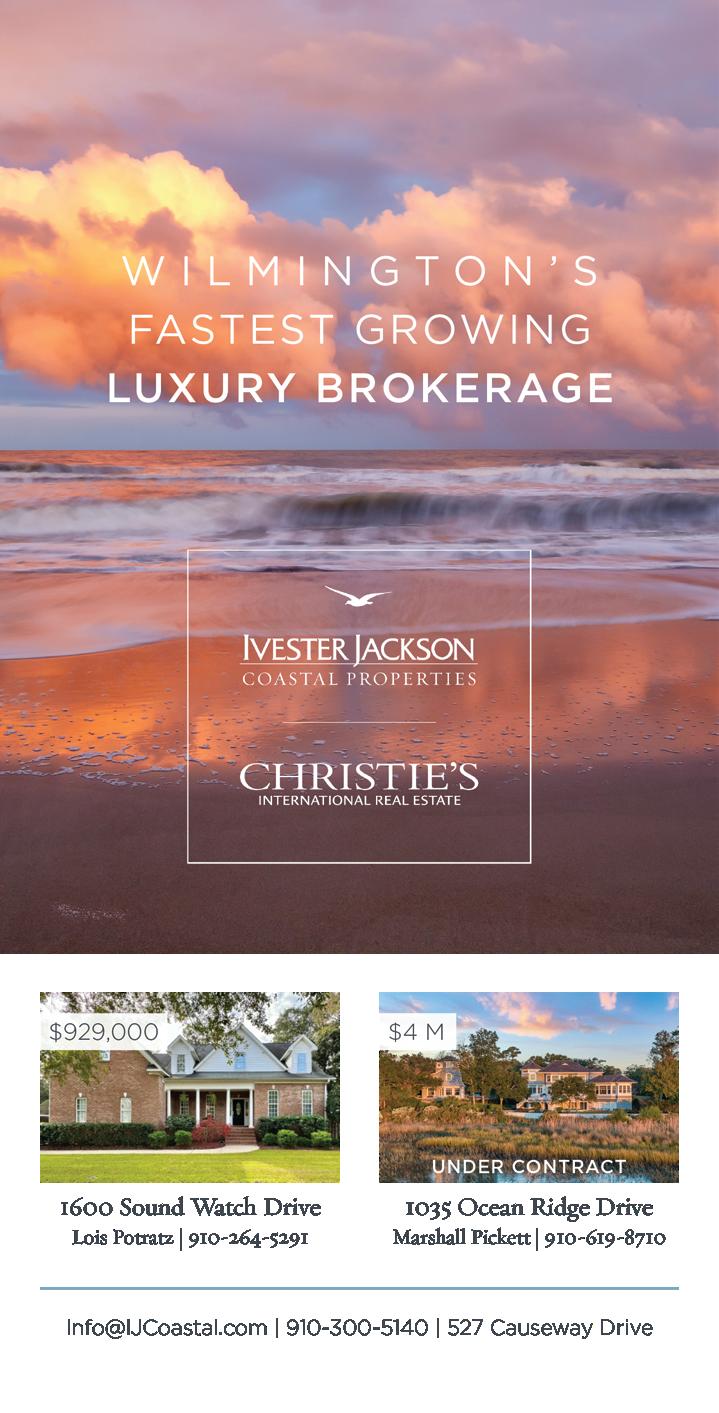
The end of 2023 and beginning of 2024 highlighted some changes in the area's residential real estate market. They included a little relief in January from an inventory shortage. More homes and other development were in the works along the busy Carolina Beach Road corridor in Wilmington and New Hanover County. Also among recent housing trends were an increase in vacancy rates and a decrease in rents at area apartment complexes.
BY CECE NUNNThe Wilmington-area market showed some relief from an ongoing lack of inventory as 2023 ended and 2024 began.
With a 21.1% increase in active listings and a 20.1% increase in new listings, January ended with a total of 2,617 active listings on the market.
That means “buyers are able to take more time than they have previously been allowed to shop,” said Amanda Parmer, Cape Fear Realtors president this year and president of BlueCoast Realty Corp. (Read more about Parmer’s background on page 34.)
In Brunswick County alone, new listings increased 18% in January compared to the same month in 2023, from 498 to 588, according to numbers compiled by the Brunswick County Association of Realtors.
Surf City and Topsail Island Realtors at a panel discussion in February said Pender County beaches were continuing to see a lack of inventory. But Pender’s overall numbers showed a more than 30% increase in listings in January, CFR numbers showed.
Development activity on Carolina Beach Road in Wilmington surged in 2023, with construction ramping up along the thoroughfare in early 2024.
Dwindling amounts of land in the city of Wilmington and southern New Hanover County is one of the significant factors boosting the popularity of rezoning requests and infill projects along the corridor.
Carolina Beach Road started as a rural road linking the city of Wilmington with Pleasure Island, said New Hanover County planning director Rebekah Roth in an August Greater Wilmington Business Journal story.
Developers and planners see the need for infrastructure that keeps up with Carolina Beach Road’s increase in activity.
“It’s a balancing act,” said Brian Chambers, assistant director of Wilmington’s Planning and Development Department. “You’re trying to get people close to services and along transit routes. That’s where this growth needs to occur, but also, you’ve got a road network that needs to be maintained to keep up with it.”

The National Association of Realtors on March 15 agreed to pay $418 million over four years to settle a case involving broker commissions.
“The settlement, which is subject to court approval, makes clear that NAR continues to deny any wrongdoing in connection with the Multiple Listing Service (MLS) cooperative compensation model rule (MLS Model Rule) that was introduced in the 1990s in response to calls from consumer protection advocates for buyer representation,” an NAR news release stated.
The release added that the NAR has agreed to put in place a new MLS rule prohibiting offers of broker compensation on the MLS.
The leaders of one of the Wilmington area’s real estate firms said they believe it’s important for buyers and sellers to have professional representation.
“Offers of compensation ensure that services are available to all and increase fair housing opportunities as well as the potential buyer pool,” stated officials with Coldwell Banker Sea Coast Advantage in a news release.
Realtors reported that $395,000 was the median sale price for the tri-county area of New Hanover, Brunswick and Pender counties in January.
“This 4.2% increase, compared to January 2023, indicates continued property value appreciation for the Cape Fear region,” a Cape Fear Realtors report stated.
Nearly 10 years ago, the Realtors group reported a median sales price of $195,000 in the tri-county region for July 2014.
“Housing has never been so expensive – for homeowners and renters, at all income levels, in every part of the country. This we know,” said David Dworkin, president and CEO of the National Housing Conference, in February.
“We also know how to make housing more affordable – build more affordable housing. It’s not rocket science, but it’s also not a quick and easy solution. (Read more about affordable housing solutions on page 30.)
“A deficit of 3-5 million housing units, depending on how we account for it,” Dworkin added, “could take 10-15 years to close.”
The Wilmington-area apartment market was experiencing an increase in vacancy rates and a decrease in rents at the end of 2023 and the beginning of 2024.
Apartment complexes advertised enticements to bring in new residents, indicating a softening not seen in recent years as rents had been on a rapid rise.
According to a Yardi Matrix report about the Wilmington area provided to the Business Journal this month, occupancy rates at apartment communities slipped from 95% in the first quarter of 2023 to 93.5% in the fourth quarter of last year. The Yardi Matrix report stated that average rental rates fell from $1,631 per month to $1,608.
Paul Loukas, partner and broker in charge of Wilmingtonbased firm Cape Fear Commercial, keeps a close eye on multifamily industry fluctuations.
“There is certainly some softening in the apartment market,” Loukas said Feb. 12, “but we expect this to improve as the fundamentals are still healthy.”
MEMBERS OF THE CURRENT WILMINGTONBIZ 100 SHARE SUGGESTIONS ON THE AREA’S FUTURE. THIS YEAR’S GROUP WILL BE ANNOUNCED IN SEPTEMBER.
TO SEE THE FULL GROUP, VISIT WILMINGTONBIZ100.COM.

ATTORNEY, WOODY WHITE LAW FIRM PLLC
“I WOULD CONSOLIDATE GOVERNMENT INTO A CITY/ COUNTY ENTITY THAT WOULD:
A) IMMEDIATELY PARTNER WITH THE NEW HANOVER COMMUNITY ENDOWMENT ON A NUMBER OF CHALLENGES FACING US;
B) LOWER THE NUMBER OF ELECTED OFFICIALS; C) MERGE KEY DEPARTMENTS TO REALIZE SCALED EFFICIENCIES; AND
D) VERTICALLY INTEGRATE THE DELIVERY OF GOVERNMENT SERVICES AND ALLOCATION OF RESOURCES TO ACHIEVE GREATER OUTCOMES.”

WILMINGTON OPTICAL FIBER PLANT MANAGER, CORNING INC.
“CORNING HAS CALLED WILMINGTON HOME FOR MORE THAN 50 YEARS BECAUSE OF THE PEOPLE WE HIRE AND DEVELOP. TO CONTINUE OUR MISSION OF CONNECTING THE UNCONNECTED, WE NEED TO CONTINUE TO HAVE STRONG LOCAL TALENT JOINING OUR TEAM. WHILE WE’VE PARTNERED WITH LOCAL SCHOOLS TO HELP DRIVE INTEREST IN STEM AND MANUFACTURING, THERE’S STILL MORE WORK TO BE DONE.”

“AS I’VE ALWAYS SAID, ONE OF MY GOALS AND EXPECTATIONS OF BUILDING A GLOBAL, WORLD-CLASS COMPANY LIKE NCINO AND RECRUITING THE TALENT TO HELP THE ORGANIZATION GROW WAS TO BRING IN THE SKILLS AND KNOWLEDGE TO START OTHER VENTURES IN THE REGION AND OFFER MORE TOP-TIER EMPLOYMENT OPPORTUNITIES TO THOSE WHOLE CALL THE REGION HOME. WHILE MEANINGFUL PROGRESS HAS BEEN MADE, IT WOULD BE GREAT TO SEE MORE TECH COMPANIES LAUNCH AND GROW.”

CEO, YWCA LOWER CAPE FEAR
“I STRONGLY BELIEVE THAT OUR COMMUNITY REQUIRES ENHANCED ACCESSIBILITY TO SERVICES THAT CATER TO VULNERABLE GROUPS. IT IS CRUCIAL THAT THESE SERVICES ARE ADEQUATELY EQUIPPED TO SAFEGUARD THE HEALTH AND WELL-BEING OF ALL RESIDENTS, PARTICULARLY WOMEN AND COMMUNITIES OF COLOR. THE PANDEMIC HAS STARKLY EXPOSED THE DISPARITIES IN HEALTH CARE, ECONOMIC STABILITY AND HOUSING FACED BY PEOPLE OF COLOR. TO ENSURE SOCIAL EQUALITY, IT IS IMPERATIVE THAT WE ADDRESS THE SOCIAL DETERMINANTS OF HEALTH.”

“MORE AFFORDABLE HOUSING! MORE HOUSING PERIOD! OUR REGION IS INCREASING IN POPULATION AND INCREASINGLY PROSPEROUS. BUT OUR MOST ESSENTIAL WORKERS – RETAIL EMPLOYEES, SERVERS, GAS STATION ATTENDANTS – ARE INCREASINGLY PUSHED FURTHER AND FURTHER TO THE MARGINS OF OUR REGION AND AS A RESULT, FORCED TO SUPER-COMMUTE AND TO LIVE PAYCHECK TO PAYCHECK. … OUR REGION IS BECOMING LESS DIVERSE, BUSINESSES ARE STRUGGLING TO REMAIN STAFFED AND GRADUATES OF OUR EDUCATIONAL INSTITUTIONS ARE TAKING THEIR TALENTS, AS WELL AS OUR LOCAL INVESTMENT IN THEM, TO OTHER CITIES.”




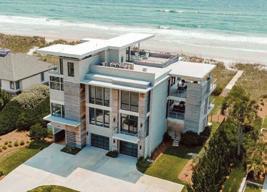











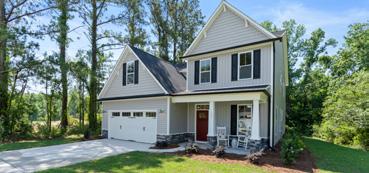



A WORKER DIRECTS A CRANE AS CREWS BUILD The Range on Oleander, an apartment complex under development by East West Partners on property at 5026 Oleander Drive in Wilmington. The Range includes more than 340 units, about 30 of which were set aside for workforce housing, meaning they are available to individuals with incomes at 80% of the Area Median Income (AMI). The household median income for Wilmington between 2018 and 2022 was about $59,000, according to federal data.